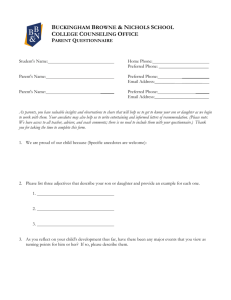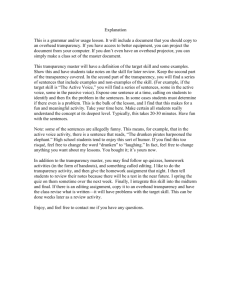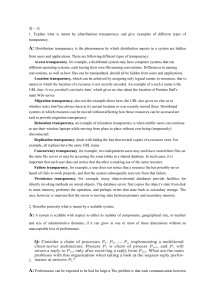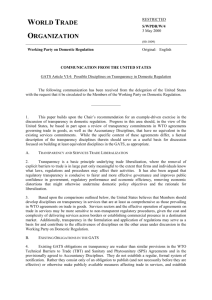Effective Presentations
advertisement
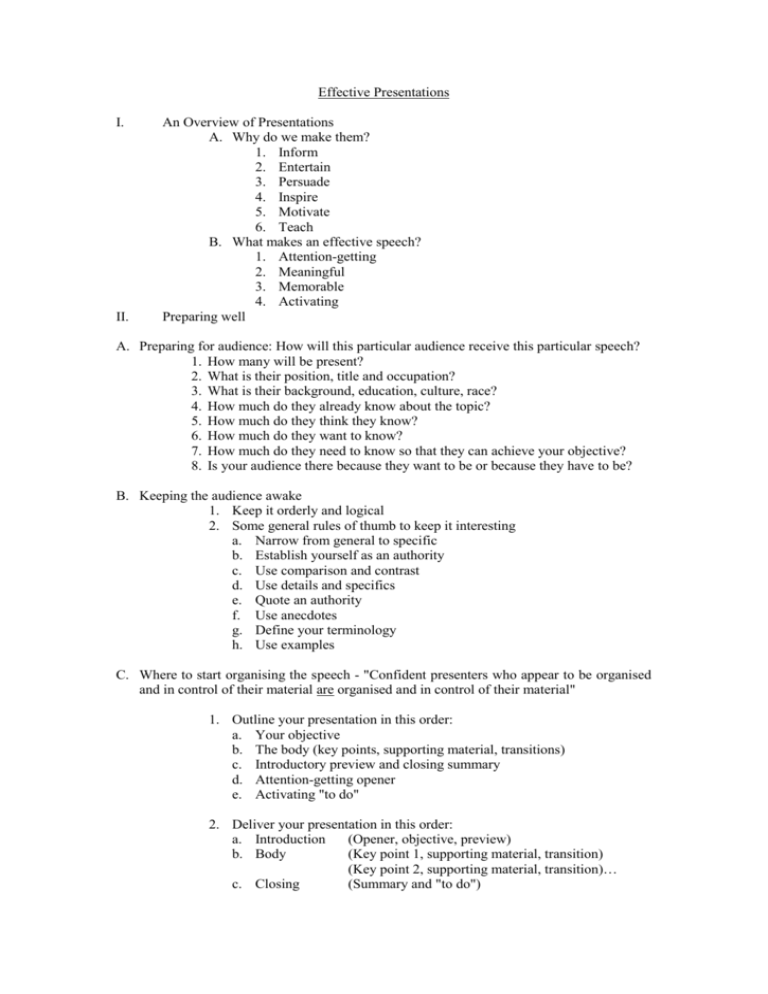
Effective Presentations I. II. An Overview of Presentations A. Why do we make them? 1. Inform 2. Entertain 3. Persuade 4. Inspire 5. Motivate 6. Teach B. What makes an effective speech? 1. Attention-getting 2. Meaningful 3. Memorable 4. Activating Preparing well A. Preparing for audience: How will this particular audience receive this particular speech? 1. How many will be present? 2. What is their position, title and occupation? 3. What is their background, education, culture, race? 4. How much do they already know about the topic? 5. How much do they think they know? 6. How much do they want to know? 7. How much do they need to know so that they can achieve your objective? 8. Is your audience there because they want to be or because they have to be? B. Keeping the audience awake 1. Keep it orderly and logical 2. Some general rules of thumb to keep it interesting a. Narrow from general to specific b. Establish yourself as an authority c. Use comparison and contrast d. Use details and specifics e. Quote an authority f. Use anecdotes g. Define your terminology h. Use examples C. Where to start organising the speech - "Confident presenters who appear to be organised and in control of their material are organised and in control of their material" 1. Outline your presentation in this order: a. Your objective b. The body (key points, supporting material, transitions) c. Introductory preview and closing summary d. Attention-getting opener e. Activating "to do" 2. Deliver your presentation in this order: a. Introduction (Opener, objective, preview) b. Body (Key point 1, supporting material, transition) (Key point 2, supporting material, transition)… c. Closing (Summary and "to do") D. Personalise your presentation 1. Know your audience 2. Elicit audience participation 3. Relate what your message means to them 4. Appear personable - agreeable, pleasant, approachable 5. Self - disclose information about yourself 6. Use personal anecdotes III. Introductions A. Goals of the introduction 1. Getting attention 2. Creating a bond of goodwill 3. Leading into the content B. Types of introductions 1. Startling statement 2. Questions 3. Story 4. Personal reference 5. Quotation 6. Suspense 7. Compliment (official, a bit boring) IV. Conclusions A. Goals of the conclusion 1. Wrapping us the speech in a way that reminds of the content 2. Hitting home in a way that makes the audience remember or act B. Types of conclusions 1. Summary 2. Story 3. Humour 4. Appeal 5. Emotional Impact V. Dos and Don'ts while presenting A. When speaking 1. Don't play with buttons 2. Don't jingle coins 3. Don't toss hair 4. Keep your glasses on or off 5. Don't tug at sleeve or collar 6. Don't say "Um" or "uh" 7. Don't wave your hands 8. Don't dance 9. Don't rustle papers 10. Don't mumble B. When using an overhead projector (OHP) 1. Switch on only when transparency is in place 2. Turn off before removing transparency 3. Allow time to read it before you start 4. Point to the transparency, not the screen 5. Use a pen to point, not your hand 6. Don't look at the transparency 7. Turn off when done with the visual 8. Don't use too many visuals (makes it hard to relate to the audience) 9. More is not always better (keep the visuals simple and necessary) 10. No more than three colours per visual C. When reading (can be boring and monotonous) 1. 2. 3. 4. 5. 6. 7. 8. 9. 10. Start without reading Look up at the ends of sentences Don't ramble on Use pauses effectively Use your full voice Vary the pitch, speed, volume Keep your head up Use facial expressions Don't turn the pages Glasses on or off D. In general 1. Practice your presentation 2. Make eye contact 3. Check the setup (room, seating, devices…) 4. Be happy (or look that way) 5. Keep your hands empty 6. Don't rush 7. Don't pass out material to be read by audience 8. Present your ideas from the listener's point of view 9. Don't use jargon (technical words and expressions) or abbreviations VI. Checklist to evaluate your presentation A. Introduction 1. Is the first sentence attention-grabbing? 2. Have you shown the benefit to the audience in listening to you? 3. Have you shown why you are qualified to speak on this subject? 4. Have you announced your structure (first I’ll…, then I’ll… and finally…)? 5. Have you shown that you understand the listener's point of view (problems, attitudes)? 6. Have you identified with the audience in the first minute or two? B. Body of presentation 1. Have you announced your first point clearly? 2. Have you used facts, examples, anecdotes, comparisons, and statistics to support your main points? 3. Have you summarised regularly? 4. Have you recapped the previous point before moving on to the next point? 5. Have you used rhetorical questions to quide your audience along your path? 6. Have you avoided jargon and abbreviations? 7. Have you used visual aids to explain complex material or add interest? 8. Are the links between each point clear and logical? C. Conclusion 1. Have you indicated that the end of your presentation is coming? 2. Have you summarised your key points? 3. Have you asked for action? 4. Have you ended on a high note?


